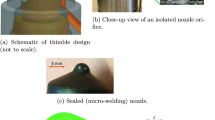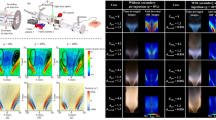Abstract
A new concept of reduced quasi-dimensional combustion model for a direct injection diesel engine is developed based on the previously developed quasi-dimensional multi-zone model to improve the computational efficiency. In the reduced model, spray penetration and air entrainment are calculated for a number of zones within the spray while three zones with aggregated spray zone concept are used for the calculation of spray combustion and emission formation processes. It is also assumed that liquid phase fuel appears only near the nozzle exit during the breakup period and that spray vaporization is immediate in order to reduce the computational time. Validation of the reduced model with experimental data demonstrated that the new model can predict engine performance and NO and soot emissions reasonably well compared to the original model. With the new concept of reduced model, computational efficiency is significantly improved as much as 200 times compared to the original model.
Similar content being viewed by others
Abbreviations
- A :
-
Constant shown in Eqs. (19) and (20)
- B :
-
Constant shown in Eqs. (6) and (7)
- C D :
-
Discharge coefficient
- d :
-
Diameter
- E :
-
Activation energy
- H :
-
Hydrogen
- k :
-
Forward rate constant
- m :
-
Mass
- N :
-
Nitrogen
- NO :
-
Nitric Oxide
- O :
-
Oxygen
- OH :
-
Hydroxyl
- K :
-
Pressure
- R :
-
Chemical reaction rate
- \(\bar R\) :
-
Universal gas constant
- RR :
-
Reaction rate
- S :
-
Spray penetration
- T :
-
Temperature
- t :
-
Time
- u :
-
Velocity
- V :
-
Volume
- x :
-
Mass fraction
- ΔP:
-
Pressure difference
- ρ:
-
Density
- τ:
-
Ignition delay
- a :
-
Air
- b :
-
Breakup
- e :
-
Equilibrium
- exp :
-
Expansion stroke
- f :
-
Fuel
- fv :
-
Fuel vapor
- i :
-
Injection
- l :
-
Liquid
- m :
-
Mixing controlled phase
- mix :
-
Mixture
- n :
-
Nozzle
- ox :
-
Oxygen
- p :
-
Premixed phase
- S :
-
Soot emitted
- sf :
-
Soot formed
- so :
-
Soot oxidized
- z :
-
Zone
References
Amsden, A. A., Ramshaw, J. D., O’Rourke, P. J., and Dukowicz, J. K., 1985, “KIVA : A Computer Program for Two- and Three-Dimensional Fluid Flow with Chemical Reactions and Fuel Sprays,”Los Alamos National Laboratory Report, LA-10245-MS.
Assanis, D. N. and Heywood, J. 1986, “Development and Use of a Computer Simulation of the Turbocompounded Diesel System for Engine Performance and Component Heat Transfer Studies,” SAE paper 860329.
Burt, R. and Troth, A. A., 1970. “Penetration and Vaporization of Diesel Fuel Sprays,” Institu tion of Mechanical Engineers.
Chiu, W. S., Shahed, S. M. and Lyn, W. T., 1976, “A Transient Spray Mixing Model for Diesel Combustion,” SAE Paper 760128.
Heywood, J. 1988,Internal Combustion Engine Fundamentals, McGraw-Hill Book Co.
Hiroyasu, H., Kadota, T. and Arai, M., 1983, “Development and Use of a Spray Combustion Modeling to Predict Diesel Engine Efficiency and Pollutant Emissions (Part 1 Combustion Modeling),”Bulletin of the JSME, Vol.26, No. 214, pp. 569–575.
Hyroyasu, H. and Arai, M., 1980, “Fuel Spray Penetration and Spray Angle of Diesel Engines,”Trans. of JSAE, Vol.21, pp. 5–11.
Im, Y. H. and Huh, K. Y., 2000, “Phenomenological Combustion Modeling of a Direct Injection Diesel Engine with In-Cylinder Flow Effects,”KSME International Journal, Vol. 14, No. 5, pp. 569–581.
Jung, D. and Assanis, D. N., 2001, “Multi-Zone DI Diesel Spray Combustion Model for Cycle Simulation Studies of Engine Performance and Emissions,”SAE Trans.: Journal of Engines, Vol. 110. No. 3. pp. 1510–1532.
Kim, H. S. and Sung, N. W., 2001, “Multidimensional Engine Modeling: NO and Soot Emissions in a Diesel Engine with Exhaust Gas Recirculation,”KSME International Journal, Vol. 15, No. 8, pp. 1196–1204.
Lavoie, G. A., Heywood, J. and Keck, J. 1970, “Experimental and Theoretical Investigation of Nitric Oxide Formation in Internal Combustion Engines,”Combust. Sci. Technol., Vol. 1, pp. 313–326.
Nehmer, D. A. and Reitz, R. D., 1994, “Measurement of the Effect of Injection Rate and Split Injections on Diesel Engine Soot and NOx Emissions,” SAE Paper 940668.
Newman, J. A. and Brzustowski, T. A., 1971, “Behavior of a Liquid Jet Near the Thermodynamic Critical Region,” AIAA journal, Vol. 9, No. 8.
Nishida. K. and Hiroyasu, H., 1989, “Simplified Three-Dimensional Modeling of Mixture Formation and Combustion in a D.I. Diesel Engine,” SAE Paper 890269.
Waldman, H., Kau, J. and Wilson, R. P., Jr., 1974, “Prediction of Transient Temperature Fields within a Vaporizing/Burning Fuel Droplet under High Ambient Pressure,” Western States Section, Combustion Institute, California State University at Northridge.
Watson, N., Pilley, A. D. and Marzouk, M. A., 1980, “Combustion Correlation for Diesel Engine Simulation,” SAE Paper 800029.
Yeom, J. Lee, M. J., Chung, S. S., Ha, J. Y., Senda, J. and Fujimoto, H., 2002, “A Proposal for Diesel Spray Model Using a TAB Breakup Model and Discrete Vortex Method,” KSME International Journal, Vol. 16, No. 4, pp. 532–548.
Author information
Authors and Affiliations
Corresponding author
Rights and permissions
About this article
Cite this article
Jung, D., Assanis, D.N. Reduced Quasi-Dimensional Combustion Model of the Direct Injection Diesel Engine for Performance and Emissions Predictions. KSME International Journal 18, 865–876 (2004). https://doi.org/10.1007/BF02990306
Received:
Revised:
Issue Date:
DOI: https://doi.org/10.1007/BF02990306




